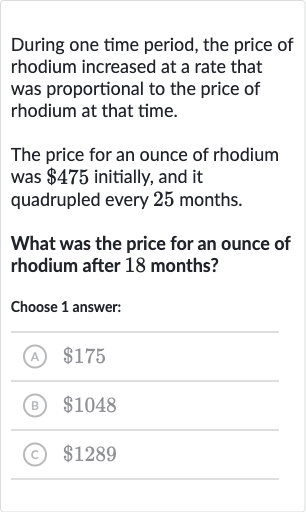AI tutor
Welcome to Bytelearn!
Let’s check out your problem:

During one time period, the price of rhodium increased at a rate that was proportional to the price of rhodium at that time.The price for an ounce of rhodium was initially, and it quadrupled every months.What was the price for an ounce of rhodium after months?Choose answer:(A) (B) (C)
Full solution
Q. During one time period, the price of rhodium increased at a rate that was proportional to the price of rhodium at that time.The price for an ounce of rhodium was initially, and it quadrupled every months.What was the price for an ounce of rhodium after months?Choose answer:(A) (B) (C)
- Understand the problem: First, we need to understand the problem. We are given that the price of rhodium quadruples every months. This means that every months, the price is times what it was at the beginning of the period.
- Calculate growth rate: To find the price after months, we need to determine the rate of growth per month. Since the price quadruples every months, we can use the formula for exponential growth: Final Price Initial Price (Growth Rate).
- Find monthly growth rate: We know that the price quadruples (which is a -fold increase) every months. To find the monthly growth rate, we can take the fourth root of , because will give us the growth rate that, when applied times, results in a quadrupling of the price.Growth Rate =
- Calculate growth rate: Now we calculate the growth rate using the fourth root of . Growth Rate = (rounded to four decimal places for simplicity)
- Apply growth rate to initial price: Next, we apply this growth rate to the initial price of over the -month period.Final Price = Initial Price (Growth Rate)Final Price =
- Calculate final price: We calculate the final price using the growth rate and the time period of months.Final Price (rounded to the nearest dollar)
- Choose closest option: Looking at the answer choices, we see that is closest to , which is option (B).
More problems from Percent of change: word problems
QuestionGet tutor help
QuestionGet tutor help
